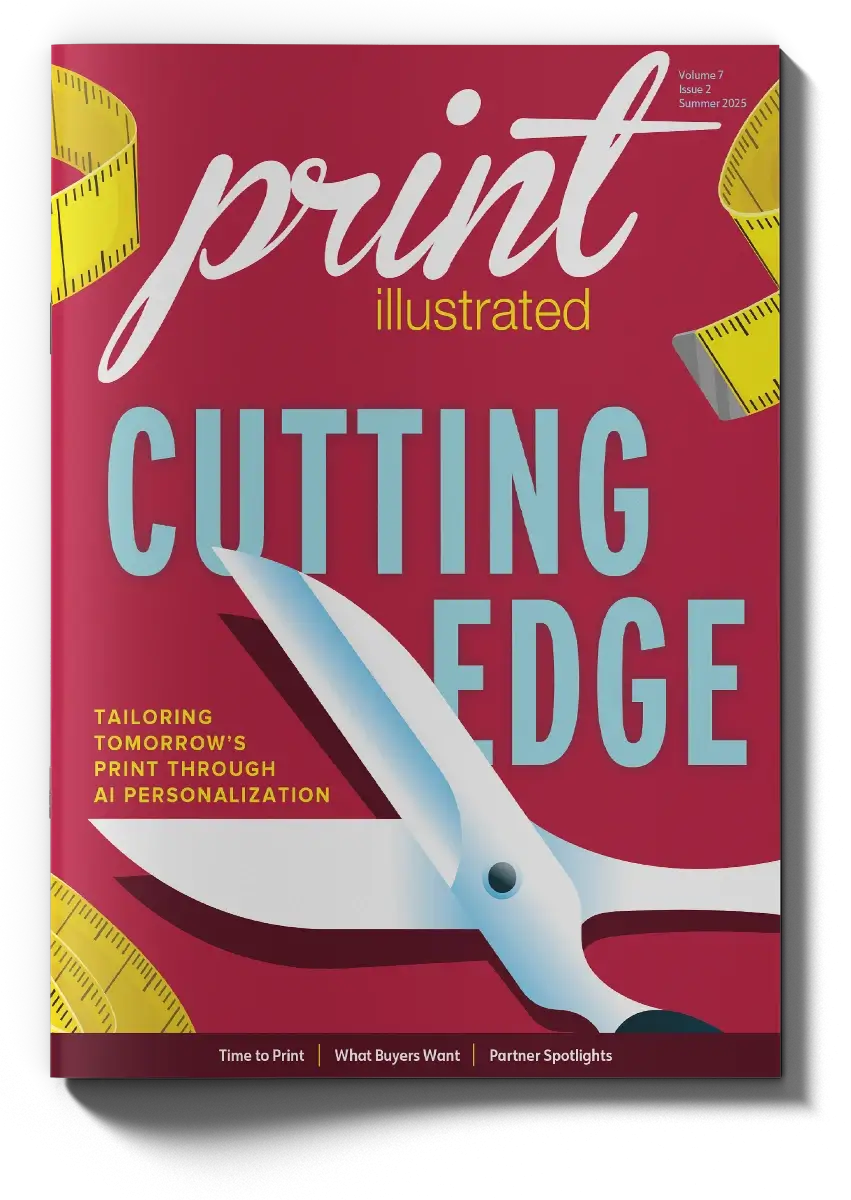Joe Rosenfield follows the mantra that if you’re going to do something, do it right and do it fast. The president of Edison Press has a firsthand look at how today’s buyers are raising the bar, expecting not only flawless quality and lightning-fast turnarounds, but also a clear commitment to sustainability.
Rather than shy away from those demands, Rosenfield led a full-scale transformation that turned a traditional offset operation into a modern, fully digital powerhouse. The result is a production model built for the pace and priorities of today’s marketplace. “Where we once completed one to five jobs per press using offset, we can now produce one to 15 jobs—and sometimes more—depending on size—thanks to digital’s speed and flexibility.”
Spoilage rates at the Sanford, Maine, printer already are at an impressively low 1% or less—a number that has dropped further since it went fully digital in 2019. “On press, spoilage has essentially reached zero,” Rosenfield says. “Digital technology ensures what you see is truly what you get. It delivers consistent quality and much faster turnaround times.”
For Rosenfield and his team, this isn’t just about keeping up—it’s about setting the pace. And in a market where buyers want it faster, better and greener, that’s exactly what they’re doing. That’s why Edison Press continues to make strategic investments in new equipment, software and automation to ensure high standards are met, even when demand peaks. “Clients appreciate our responsiveness and reliability. While we aim to meet every request, we’re also mindful of the pressure it can place on our team. Strategic investments help us maintain both quality and efficiency, while also supporting a healthier work balance.”
“Digital technology ensures what you see is truly what you get. It delivers consistent quality and much faster turnaround times.”
– Joe Rosenfield, President, Edison Press
Identifying and eliminating bottlenecks has been a core focus of this transformation. Historically, the company concentrated on press and bindery upgrades to improve efficiency. But as Rosenfield explains, the most significant opportunities now lie at the front end of the operation. “This year, we’ve invested heavily in front-end automation to reduce manual tasks and streamline workflows. Even saving an account rep 30 minutes a day can have a meaningful impact on the overall process.”
Rosenfield remains deeply committed to maintaining the one-on-one client relationships that have long defined Edison Press. Regular conversations with customers provide valuable feedback on evolving demands, helping the company stay ahead of changing expectations. “The message has been clear: they want it fast, and they want it right. But what really sets us apart is our transparency. We keep clients informed throughout every step of the process, setting clear expectations and consistently delivering on our promises.”
The printer’s journey toward sustainability began as a natural byproduct of its digital transition. Edison eliminated the need for a chemical room, drastically reducing its environmental footprint. Paper waste has been minimized, and eco-responsible ink disposal methods have been adopted. “While these changes weren’t initially driven by sustainability goals, they’ve resonated positively with our clients,” Rosenfield says.
Rosenfield sees buyer expectations continuing to rise. “We’re leading the way for some of our clients now—using our knowledge of their preferences to make informed decisions on their behalf. That shift requires responsiveness and foresight. We want to stay ahead of the curve, anticipating needs before they arise and delivering solutions that exceed expectations.”
Building Efficiency Through Automation
At ColorMark Printing, the formula for meeting buyer demands is simple: embrace automation, optimize production and maintain a relentless focus on quality. The Carrollton, Texas, printer provides B2B storefronts that give its clients 24/7 access to printing solutions.
Once an order is placed, automated systems optimize the file for the right press and paper size, then seamlessly route it to the correct department. This process allows ColorMark to handle tens of thousands of orders each year without increasing pre-press staffing. ColorMark also develops custom applications tailored to each client’s needs.
For example, across 1,200 franchises, the company’s system uses templates and a comprehensive pricing database to generate menus and marketing materials with minimal manual input. “This level of automation streamlines production while maintaining accuracy and precision,” says Jacques Cangelose, Process Optimization & Revenue Generating Manager.
But automation alone isn’t enough. ColorMark also prioritizes ongoing training and preventative maintenance to ensure consistent, high-quality output. “Training isn’t a one-time event; it’s an ongoing process,” Cangelose says. “Presses are recalibrated at the start of every shift and again midday to ensure precision and that our operators review previously printed materials to maintain visual consistency.”
“We continuously monitor advancements in hardware and software—not just for today, but for the next one, five and 10 years. That’s how we stay valuable to our clients and help shape their success.”
– Jacques Cangelose, Process Optimization & Revenue Generating Manager, ColorMark Printing
On the sustainability front, ColorMark’s highly efficient processes minimize waste. Only three extra sheets are printed for cut-only jobs and 15 for those requiring finishing. The company also offers a range of recycled paper options and focuses on using recyclable plastics for high-use products, ensuring durability without compromising eco-responsibility.
To manage the constant balancing act between speed, quality and sustainability, ColorMark empowers managers to anticipate potential disruptions and adjust workflows in real time. “Our system is fluid enough to handle interruptions while keeping efficiency high,” Cangelose says.
Strong client relationships are key to this success. Weekly meetings help ColorMark stay closely connected to client needs, allowing the company to identify inefficiencies and implement custom-built solutions. “Although developing these systems can be complex up front, the long-term benefits are significant,” Cangelose says. “It strengthens partnerships and creates lasting value.”
Cangelose believes staying ahead means preparing for both immediate and long-term trends. “We continuously monitor advancements in hardware and software—not just for today, but for the next one, five and 10 years. That’s how we stay valuable to our clients and help shape their success.”
For today’s printers, the path forward requires clear-eyed investments, a willingness to rethink traditional workflows and a firm commitment to sustainability. Those who can strike the right balance won’t just keep up—they’ll lead.
Top 5 strategies for balancing speed, quality and sustainability
- Invest in Automation and Digital Workflows
Automate front-end and production processes to reduce bottlenecks and accelerate turnaround times. Digital workflows improve consistency, minimize errors and cut waste. - Prioritize Preventative Maintenance and Training
Keep equipment running efficiently and ensure quality output through regular maintenance and ongoing employee training. Doing it right the first time saves time, materials and costly rework. - Embrace Sustainable Materials and Practices
Use recycled paper stocks and eco-friendly substrates where you can. Reduce chemical use through digital processes and adopt responsible ink disposal methods to meet client expectations for sustainability. - Optimize for Versioning and Personalization
To help build personalized experiences, invest in technologies that simplify versioning and variable data printing to efficiently serve diverse markets and minimize waste. - Communicate and Collaborate with Clients
Transparency builds trust. Keep clients informed and collaborate to forecast future needs, allowing you to deliver faster, smarter and more sustainable solutions.
Sources: Joe Rosenfield, President, Edison Press; Jacques Cangelose, Process Optimization & Revenue Generating Manager, ColorMark Printing

